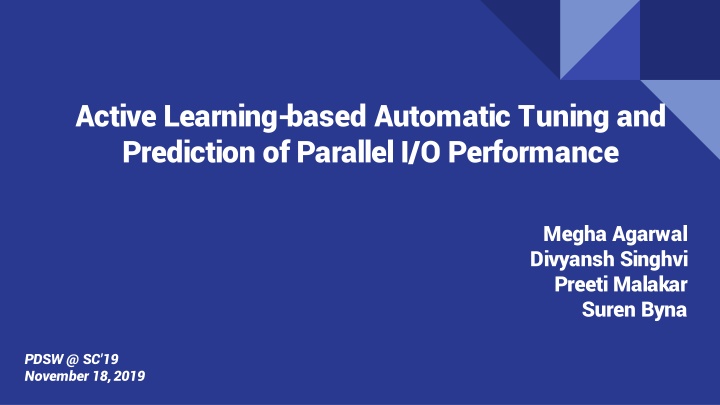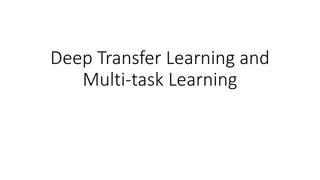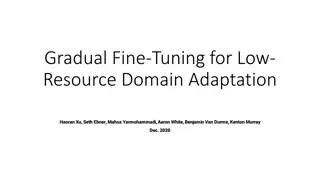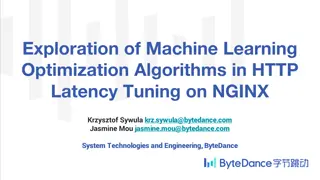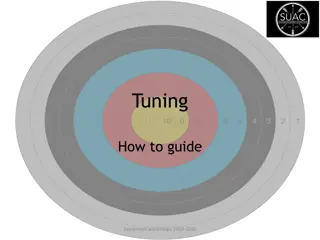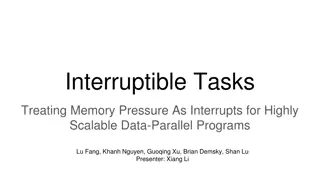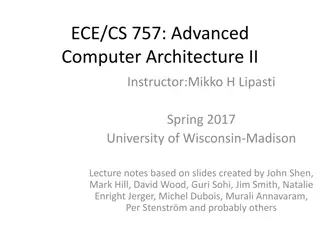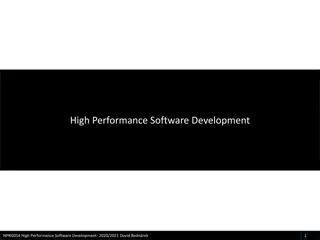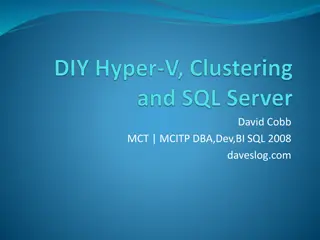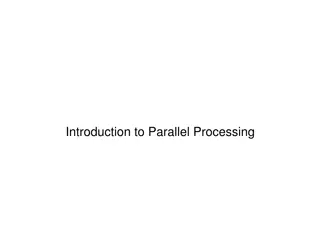Active Learning for Automatic Parallel I/O Performance Tuning
This content discusses active learning-based techniques for automatic tuning and prediction of parallel I/O performance to address challenges arising from the complex parallel I/O stack. It highlights contributions such as ExAct and PrAct, which enhance read and write performance through auto-tuning approaches. Prior work on heuristic-based search and analytical models is also examined in the context of optimizing I/O performance.
Download Presentation

Please find below an Image/Link to download the presentation.
The content on the website is provided AS IS for your information and personal use only. It may not be sold, licensed, or shared on other websites without obtaining consent from the author.If you encounter any issues during the download, it is possible that the publisher has removed the file from their server.
You are allowed to download the files provided on this website for personal or commercial use, subject to the condition that they are used lawfully. All files are the property of their respective owners.
The content on the website is provided AS IS for your information and personal use only. It may not be sold, licensed, or shared on other websites without obtaining consent from the author.
E N D
Presentation Transcript
Active Learning-based Automatic Tuning and Prediction of Parallel I/O Performance Megha Agarwal Divyansh Singhvi Preeti Malakar Suren Byna PDSW @ SC'19 November 18, 2019
I/O Performance Statistics Few applications achieve less than 1% of maximum I/O throughput Source: Huong Luu, et al., A Multiplatform Study of I/O Behavior on Peta- scale Supercomputers . HPDC '15 2
Parallel I/O Challenges Exponential growth in compute rates as compared to I/O bandwidths Depends on interaction of multiple layers of parallel I/O stack (I/O libraries, MPI-IO middleware, and file system) Each layer of I/O stack has many tunable parameters I/O parameters are application-dependent A typical HPC application developer (expert in their scientific domain) resorts to default parameters 3
Parallel I/O stack Complexity Application HDF5 (Alignment, Chunking, etc.) MPI I/O Tunable parameters: cb_nodes, cb_buffer_size, (Enabling collective buffering, Sieving buffer size, collective buffer size, collective buffer nodes, etc.) Parallel File System (Number of I/O nodes, stripe size, enabling prefetching buffer, etc.) Tunable parameters: stripe size, stripe count, Storage Hardware Storage Hardware 4
Our Contributions An auto-tuning approach based on active learning that improves both read and write performance. 1. ExAct: An execution-based auto-tuner for I/O parameters (achieves up to 11x speedup over default). 2. PrAct: A fast prediction-based auto-tuner for I/O parameters (can tune I/O parameters in 0.5 minutes). 5
Prior Work Heuristic-based search with a genetic algorithm to tune I/O performance Analytical models Disk arrays to approximate their utilization, response time, and throughput Application-specific models Herbein et al. use a statistical model, called surrogate-based modeling, to predict the performance of the I/O operations 6
Overall Architecture of I/O Autotuning I/O Kernel Prior Work I/O Autotuning Framework Refitting Overview of Dynamic Model-driven I/O tuning Model Generation All Possible Configuratinos Heuristic-based search with a genetic algorithm to tune I/O performance Analytical models Disk arrays to approximate their utilization, response time, and throughput Application-specific models Herbein et al. use a statistical model, called surrogate-based modeling, to predict the performance of the I/O operations Optimize I/O Training Set (Controled by user) Training Phase Refit the model Top k Develop an I/O Model Configurations Pruning XML File All Possible Values I/O Model H5Tuner I/O Benchmark Top k Configurations Executable Exploration Performance Results HPC System Select the Best Performing Configuration Storage System 7
Parameter Tuning Challenges Large number of I/O parameters inter-dependent on each other. Real valued parameters do not allow brute forcing the parameter space to find optimal parameters. Application-specific models are limited to specific I/O patterns 8
Bayesian Optimization Limit expensive evaluations of the objective function by choosing the next input values based on those that have done well in the past Mathematically we can represent our problem as : x* = argmaxx Xf(x) - f(x) represents our objective function to minimize which in our case is run time of application, x is the value of parameters x* is best value found for each of parameters in sample space X. - - 9
Prediction-based Auto-tuning (PrAct) Model Developed a performance prediction model using Extreme Gradient Boosting (XGB). PrAct uses predicted runtimes in the objective function in Bayesian Optimization model. This reduces the time to obtain the best I/O parameters. 11
Summary of Approaches ExAct -Objective function obtains output by running the application on input parameters Predict is an offline model trained on dataset that predicts I/O bandwidth for given set of input parameters. PrAct-Objective function obtains output by running Predict on input parameters 12
Collective I/O is disabled in S3DIO, i.e. with 50% prob, it has no impact Bias and Learning Plots Loss distribution Cb-buffer size distribution Romio cb_read Romio cb_write Romio ds_read stripe size distribution Stripe count distribution Romio ds_write Red -Initial probability distribution Blue -After training prob. distribution Configuration: 200X400X400 on 4X4X8 processes S3DIO 13
Application I/O Kernels for benchmarking S3D-IO 40 input configurations BT-IO 19 input configurations IOR Generic I/O 45 input configurations 14
System Configurations HPC2010 (464-node supercomputer) at the Indian Institute of Technology (IIT), Kanpur Used a maximum of 128 processes. CrayXC40 at NERSC, LBNL Used a maximum of 512 processes. 15
Results 16
S3D-IO default vs. ExAct on HPC2010 (16 128 processes, 8 ppn) X-axis: Increasing data sizes Y-axis: I/O bandwidths in MBps 17
IOR I/O bandwidths for varying node counts. Strong scaling on 16 256 processes. IOR I/O bandwidths for varying transfer sizes. Data scaling on 64 cores with 100 MB block size. 87% read and 20% write improvements Default vs. ExAct I/O bandwidths using IOR on HPC2010 18
Generic-IO default vs. ExAct on HPC2010 (2, 4, 16, 28 nodes) Significant improvement on large data size X-axis: number of particles (in millions) Y-axis: I/O bandwidths in MBps
S3D-IO default vs. ExAct on Cori (2 16 nodes, 32 processes per node) X-axis: Number of nodes Y-axis: I/O bandwidths in MBps Weak scaling results for S3D-IO 20
ExAct Result Summary Benchmark Read(Avg) Write(Avg) Read(Max) Write(Max) S3D-IO 1.97X 2.21X 11.14X 4.03X IOR 2.1X 1.0X 4.73X 2.23X BT-IO 1.07X 1.76X 2.93X 4.86X GenericIO 1.44X 1.51X 3.04X 3.06X 21
Results Analysis Benchmark S3D-IO (200 x 200 x 400) on 4 x 4 x 8 processors (16 nodes) on HPC2010 Default parameters stripe_size = 1 MB, stripe_count = 1, cb read/write = enable, ds read/write = disable, cb_buffer_size = 16 MB, cb_nodes = 16 Read/write 3002 /1680 MBps ExAct parameters stripe_size= 4 MB, stripe_count = 21, cb read/write = disable/disable, ds read/write = enable/disable, cb_buffer_size = 512 MB, cb_nodes = 13 Read/write 1198 / 293 MBps Time 12.65 minutes 22
Performance Prediction Model (Predict) Accuracy Median absolute percentage error and R2measure for various benchmarks on HPC2010 (rows 1 4) and Cori (last row) using XGB model-based prediction 23
Prediction Model Accuracy Scatter plots of XGB- predicted values vs. measured values of write bandwidths for all benchmarks on HPC2010 IOR BTIO S3D Generic-IO (30/70 split of train/test data) 24
Results PrAct S3D-IO weak scaling on unseen configurations BT-IO with unseen configurations. 25
Results PrAct PrAct was also evaluated for configurations that were not present in the training data Maximum of 1.6x and 1.2x performance improvement in reads and writes in S3D-IO Maximum of 1.7x and 2.5x performance improvement in reads and writes in BT-IO Observed degradation in read bandwidths in case of IOR, especially at high node counts. This is expected as the R2scores were low 26
ExAct vs. PrAct Time vs. Performance Tradeoff Average training time of PrAct is 18 seconds whereas that of ExAct is 13 minutes (varies with the run time of application) PrAct achieves a maximum performance improvement of 2.5x whereas ExAct achieves 11x improvement 27
Conclusions Presented execution-based (ExAct) and prediction-based (PrAct) auto-tuners for selecting MPI-IO and Lustre parameters ExAct runs the application and learns, whereas PrAct uses predicted values from analytical model to learn The only system-specific inputs to the model is the range of stripe counts Upto 11x improvement in read and write bandwidths ExAct is able to improve write performance of large data sizes (e.g., 1 billion particles in GenericIO) by 3x Predict model uses XGBoost, and obtains less than 20% median prediction errors for most cases, even with 30/70 train/test split 29
